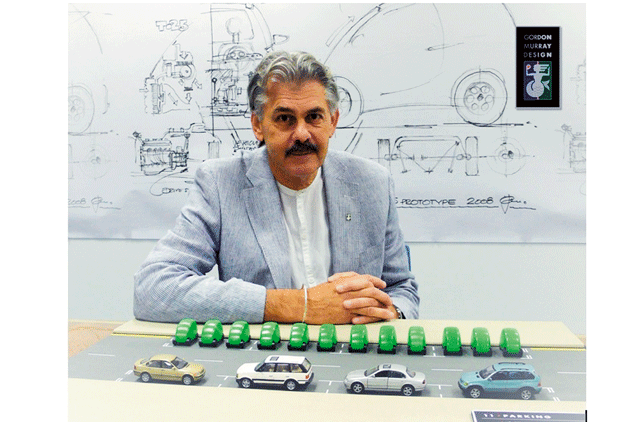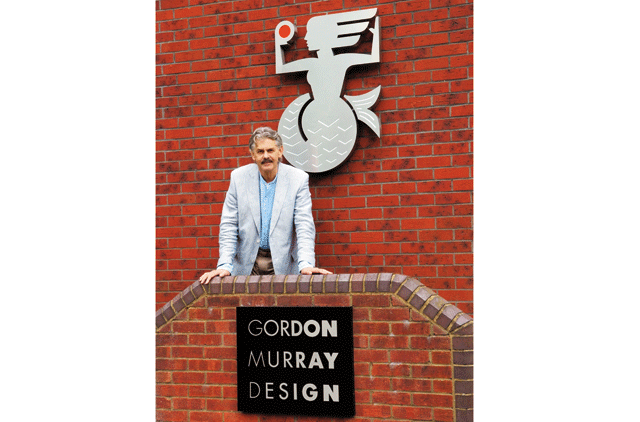
Hybrids are nonsense and the Bugatti Veyron is a giant waste of time.
In most petrolhead societies, you'd be lynched for saying at least one of the above, but when your name is Gordon Murray and your CV reads like a who's who of the greatest racing cars on the planet, you can get away with almost anything. And lately, the South African-born engineer is getting away with designing ultra low-cost and ultra-green urban runabouts. A far cry from his days of 1,500bhp BMW Formula 1 cars and the ground-breaking McLaren F1.
Throughout his career, Murray had a knack for doing a number on you, pulling off a major surprise. He was one of the most innovative designers in the game, and by the time hewas just 19 years old, he'd already built hisown engine and fitted it to the first Gordon Murray chassis.
"Nobody really had any money after the war. In the early Fifties, my dad was a motor mechanic and people in South Africa couldn't afford to buy racing cars. They were modifying, building their own… In those days, you could unbolt the body and throw it away, tune the engine a bit, make a lightweight aluminium body and you had a racing car.
"I can remember from about five to six years old watching my dad work on these cars, going to races around Durban and Pietermaritzburg every weekend. I grew up with it in my blood really. I wanted to be a racing driver. By the time I had a licence to drive, I'd built a racing car.
"And it was a good car, I actually won races in it — which wasn't too difficult in South Africa in those days. But then I decided that I quite liked the design side of it.
"Colin Chapman was always my hero; I wasn't interested in following anybody else to be honest. So I started writing to people whenI was still in South Africa, because I'd already booked my ticket on a boat. I came over ona cargo boat, that was the cheapest way to get to England. I'd written to Lotus and got a personal reply from Chapman. I think probably what impressed him was the fact that I'd built my own car and engine when I was that young.
"Unfortunately there was a recession as I arrived. By the time I got to Lotus for the interview — the second day I was in England — they had to lay off 60 people. I didn't getthat job… I spent the next six months scrounging around and eventually I got a job with the Brabham F1 team in 1970. It was indeed a stroke of luck.
"And then Bernie Ecclestone arrived. Within a space of about 18 months, he had bought the company from Jack, fired all the other designers, and kept me."
As Murray laughed under his thick signature moustache, he admitted that to this day he has no idea why Bernie kept him.
"He's made jokes about it in various articles and books, but I like to think he saw something in me. So at the age of about 25, I was chief designer for the Brabham F1 team. And I got to test drive the cars too…"
Murray was responsible for ground-breaking machines, some of the most innovative in the field. His notorious Brabham BT46B ‘fancar' won on its maiden outing at Anderstorp and was promptly banned. Nobody could pass Niki Lauda that day, not just because of the fan sucking him down to the ground, but the amount of debris the blades were spewing out the back too.
"My favourite F1 cars? Phwoar! It was probably — I've got a few favourites — but it was probably the BMW-powered BT52 which won the championship. It was a huge challenge to design a car to cope with all that power. That was also the first pit stop car…I started those in F1. They were pretty shocked when we first turned up in the pits. I think they wondered what on earth we were doing, but I'd done the calculations and worked out that with half the weight of fuel and with new tyres there was enough advantage to overcome the disadvantage of stopping in the pit.
"F1 today is thousands of little details. Because of the rules, the cars are all similar. In my day, you could have an idea in the bath, stick it on the car tomorrow and the next GP go a second-and-a-half quicker and really upset the other teams, which I used to enjoy."
After 17 years at Brabham, Murray had had just about enough of "living out of a suitcase". The self-made genius already won championships and 30-odd races. But Ron Dennis bumped into him and managed to persuade him to make it 20 years in F1, or "enough for any human being, really." Then Mansour Ojjeh, the Saudi-born French McLaren partner, and Dennis were talking about expanding the group to include a road car company. "So I left the F1 team, walked into an empty building and, as they say, the rest is history. We built up a team of people and designed the McLaren F1; went on to do work for BMW; went on to race the F1s; did the SLR programme… Quite a successful little company.
"But the SLR was a bit of a mixture really. It could've been a much better car than it is. The F1 was a very focused attempt at being the world's best driver's car and the world's best engineered car. When you get a Bugatti Veyron and the SLR, which aren't designed by one single person in charge, you always end up with something that doesn't know whether it's a GT car, a sportscar, or a luxury car."
Knowing well how much Murray despises outright top speed claims, I gathered up the courage anyway to steer the conversation towards how the McLaren F1 compares to the SSCs, Koenigseggs and Veyrons of the world. "I think it's all a load of nonsense really. Top speed was never a target with the F1, it really wasn't. It was going to do a high top speed because it has a very slippery small frontal area and over 600 horsepower. We didn't honestly care whether it would do 370kph or 385kph. I think our calculations showed 378kph if I remember correctly. If it would've been 330kph or 420kph, I wouldn't have really minded. The target was to build the ultimate driver's car."
Before leaving McLaren in 2004, Murray was involved in one last hurrah, then titled Project 8. It was to follow the F1 mantra, with a smaller normally aspirated V8, a carbon monocoque, a transverse automated DCT ‘box and a total weight below 1,200kg. It all sounds a bit like the McLaren MP4-12C, doesn't it?
"Well, with the F1 we were the first people in the world to make a composite structure car and at least they kept that. But I would have never done a turbocharged engine. Apart from the carbon monocoque, the MP4-12C's philosophy seems different."
Thankfully for petrolheads worldwide, Murray isn't done with sportscars just yet. Even though his latest endeavour focuses on low-cost, high-volume manufacturing.
"You know, I've done so many sportscars, then everybody tried to make a McLaren F1 and go for top speed, etc. I lost interest. I'd love to do another sportscar but it won't be like that. I've sort of been there and done that and I neededa new challenge. I've been thinking for a long time about how we could get F1 technology into low-cost manufacturing. Selling a car for six to seven grand that's got F1 thinking in it is a much bigger challenge than doing a McLaren F1.
And it's a challenge that Murray met head-on, inventing a manufacturing process called iStream and developing two cars — T.25 and T.27 — to showcase this technology.
"iStream is a complete rethink. It's very disruptive. It doesn't use any of the existing technology for making cars. Because you know what we do at the moment: we dig a lot of steel and ore out of the ground, we melt it down, make flat sheets and then we stamp them into about 350 panels. You need a huge press shop with lots of energy and lots of capital investment. We don't need any of that. We don't use one major stamping on the car at all. Then you have a massive robotised line that spot welds all that together. We don't need any of that either. And then you go through rust prevention and paint. We don't need any of that either." Murray obviously loves telling that story.
This "disruptive process" uses a very simple tubular frame, joining up all the major points like the suspension, engine mounts and fuel tank. Gordon Murray Design also invented composite honeycomb panels which they can produce in two minutes and which cost a few euros each!
"We've also now got a few people interested in buying the T.25 and T.27. Which is nice. We're in discussion with a couple of companies; they can put their own styling on, their own engine in or whatever. For iStream manufacturing we've had over 40 enquiries from 17 different countries. We don't care what the shape ofthe car is, or even what fuel and what engine it's got, as long as we sell a licence to manufacture the car. That's all we're interested in. We'renot pushing particularly for electric, or petrol, diesel, hybrid…"
And out of the 40 or so serious enquiries for iStream, eight of the interested parties are major carmakers. But I'm now itching to get back to the supercars…
"Well, I've certainly got one more supercar left in me, but it won't be the sort of thing that other people are building at the moment. It will be completely different, it will be a supercar for the future. And I'm not talking about powertrain, hybrid or electric or any of that nonsense. It will have a proper petrol engine.
"The car itself will hopefully embody everything the F1 embodied, though it won't be reaching for 320kph. It will be more concentrated on a driving machine, a pure piece of art and engineering again.
"I want supercars to be pure. Nobody wants a supercar that doesn't make any noise. The F1 used all the current materials and manufacturing technologies from Formula 1 and aerospace that were around in the early Nineties. So what I'd be looking for if we were doing this car in, say, five years' time, is again using all the latest technologies and some new ones that maybe we haven't seen yet.
In other words, Gordon Murray wants to get back to the top of the performance world.
"I don't see anybody doing what we're doing. From a design and engineering point of view, we'd be taking on all the people we took on last time; Ferrari, Porsche... But from the performance point of view, we don't care. We really don't care. I didn't care with the F1, it just came out like that… We could've gone for top speed honours. Paul Rosche, who is, I think one of the best engine designers on the planet, asked me to do it. I still think his McLaren F1 engine, that V12 S70 engine, is probably the best sportscar engine ever made.
"When people started trying to go faster than the F1, he actually asked me, ‘Are you interested in going faster?' I said, ‘Not really, but why did you ask?' to which he answered, ‘Well, I know the crank and the heads on the engine are good for 1,000 horsepower. If you want top speed I'll put four turbos on it and you can have 1,000 horsepower quite safely.' I then did some calculations and worked out the car would do about 450kph or something ridiculous like that."
In any case, whatever Murray ends up with as his next supercar, we'll certainly pay attention. But you can bet it won't be alternative energy.
"Obviously the internal combustion engine has some way to go and it will be around for a long, long time. I think eventually, eventually, hydrogen might be viable. Right now it's just too complicated, takes too much energy to make and it's very difficult to store. Some sort of hydrogen usage will take place in the future, but I think in 20-25 years' time. Electric cars and hybrids are not a serious long-term option. We need to move onto the next thing."
And so we do move onto the next thing and I've left my most childish question as the last. "Mr Murray, what's your favourite car?"
As ever, the mastermind springs a surprise. "I've got one actually. My favourite is a Series 3 Lotus Elan, and I've got one of those. Then there's the Porsche Spyder 550. Unfortunately, I can't afford a real one but I have a replica. They only made about 40 of the real ones,and they're over a million quid now. My favourite Ferrari is actually a racing car, a 1966 Dino 206 SP. Love that car… It was designed by a very good friend of mine, Mauro Forghieri, so that makes it even more special. From the modern times, a Renault Kangoo is one of the most clever cars of the last 20 years. I've got two of those…"
Yup, the man responsible for arguablythe greatest road car in history, championship winning F1 bolides, Mercedes-Benz's ultimate exercise in excess, and a revolution in car manufacturing, commutes to work in a French van. Wonder what he'll dream up next?
1,500bhp
Paul Rosche's turbocharged four-pot BMW engine was the most powerful F1 engine ever,in qualifying trim. Murray's job was to tame the power
CV in short
think again
Murray wants iStream to be a revolution. It certainly sounds like it. The composite body panels his company invented cost just a few euros each. This very strong material gets bonded by robots into the steel frame, so what you have is something very strong in torsion bending and crash safety. And the way Murray uses the fibres is "absolutely pure F1 thinking, but it's not F1 costs, because we've thrown the expenses and the time right out of it." That's iStream, and that means the body can be non-structural so it can change. Down the factory line it can be a car, a van or a truck…
CV in short:
Brabham F1
In the Seventies Brabham did F1, F2, F3, Formula Atlantic and Indy, so Murray was just a junior designer. In 18 months though, things changed
Mclaren
Murray was about to quit F1 in the mid-Eighties, but Ron Dennis poached him for three more years, where Murray played a role in the most successful F1 car ever —the MP4/4
Mclaren f1
Together with ‘Camshaft Paul' Rosche and his BMW V12, Murray was responsible for one of the greatest road cars ever. The F1 won Le Mans first time out
Mclaren SLR
"When you have a committee involved in design, the cars always get watered down a little bit in my opinion," said Murray. But he still admires the SLR's engineering











